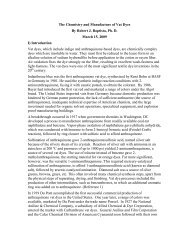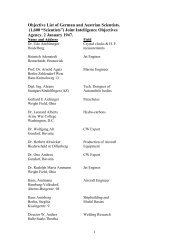International Dyestuff Industry - ColorantsHistory.Org
International Dyestuff Industry - ColorantsHistory.Org
International Dyestuff Industry - ColorantsHistory.Org
Create successful ePaper yourself
Turn your PDF publications into a flip-book with our unique Google optimized e-Paper software.
Figure 2. Retorts. Edelstein Collection, Hebrew University.<br />
Large tanks were used as condensers, with two or three retorts distilling into each one, until<br />
an explosion during cleaning out revealed the presence of excessive amounts of hydrogen.<br />
Thereafter, the operation became safer when specially designed raised iron troughs, b,<br />
smaller than the original receivers, were introduced. Distillate entered at one end of the<br />
trough and the other end was plugged with a loosely-fitting piece of wood that allowed slow<br />
diffusion of the hydrogen into the atmosphere. The tops of the troughs were covered with<br />
lids, bb, opened and closed with the aid of long handles. After accumulated hydrogen had<br />
been released by opening the lids, anthracene was removed, ground and dried. Potash was<br />
recovered from the retorts for re-use.<br />
The manner in which the subsequent oxidation and sulfonation steps were carried out by<br />
Perkin & Sons are of special interest because they represent the basis of the first bulk<br />
manufacturing methods for artificial alizarin carried out by any company, and were used<br />
almost exclusively at Greenford Green until the middle of 1870. Perkin's graphic description<br />
fully conveys the atmosphere of large scale working in the early dye industry.<br />
The oxidation of anthraquinone with potassium dichromate was carried out as follows:<br />
The purified anthracene was ground very thoroughly with water under<br />
edge runners. It was then placed in a leaden-tank, with twice its<br />
weight of potassium bichromate dissolved in water. About three parts<br />
of sulphuric acid, previously diluted, were then added. After well<br />
stirring, a very energetic reaction set in, the mixture boiling up to near<br />
the top of the tank. When this had been moderated, steam was turned<br />
on, and the mix- ture well boiled for an hour or two. The yellow<br />
granular anthraquinone was then separated from the chrome alum<br />
solution, well washed, and after it had drained, though still wet, was<br />
purified by sublimation. At first we used two iron retorts, with<br />
openings at the top, and connected with a wide bent tube for this<br />
purpose, the one acting as a sublimer, the other as a receiver.<br />
Afterwards we employed retorts, with an outlet from the end<br />
connected with a large sheet-iron cylinder, having one end closed with<br />
canvas only.<br />
The wet crude anthraquinone, when heated, gave off a considerable<br />
amount of steam which helped to carry the vapor of the anthraquinone<br />
forward, which condensed as an impalpable powder. As the<br />
sublimation proceeded, and less steam was given off, small crystals of<br />
anthraquinone deposited. On opening the retorts after the operation,<br />
magnificent hard yellow crystals were often found suspended from the<br />
roofs of them.





